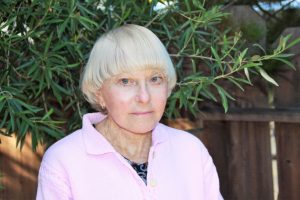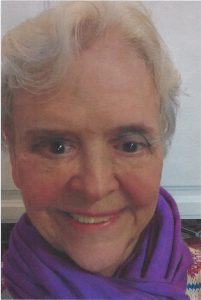Endocrine News gets the patient and physician perspective on thyroid eye disease. Patients discuss how it has affected their lives and clinicians explain the limited treatment choices. However, new options may be available soon.
Christine Gustafson, of Monterey, Calif., swam a mile a day and biked everywhere she went. When she noticed her heart was racing and that she was losing weight while one of her eyes seemed to be closing shut, she went to her doctor and her doctor asked her whether she’d experienced any anxiety as well. “And I said, ‘Oh, you have no idea how much anxiety I have,” Gustafson says. “Out of the blue, a lot of anxiety.”
The doctor tested her blood and called her the next day, telling Gustafson that she needed to see her endocrinologist immediately, that the numbers of autoantibodies that came back from her blood tests were the highest the doctor had ever seen. Gustafson rode her bicycle to her endocrinologist’s office, a fact that caused her endocrinologist to doubt the initial blood tests. “She seriously thought they weren’t my blood tests,” Gustafson says. “She said, ‘They get mixed up all the time. There’s no way these numbers would be you.’”
When the second tests confirmed the original results, Gustafson was diagnosed with Graves’ disease and thyroid eye disease (TED). Gustafson’s eye wasn’t closing shut; her other eye was opening wider.
Nancy Patterson, of Hendersonville, N.C., was diagnosed with TED 32 years ago, and in those three decades, she has seen no breakthroughs in TED, at least none that benefitted her. “The treatments have been the same,” she says. “There is now a great deal more research, but for 32 years there hasn’t been [a clinical breakthrough].”
Up to half of Graves’ disease patients develop TED, which is a separate condition from Graves’, characterized by “bulging” or protruding eyes, staring, and double vision, symptoms that, for now, patients simply have to live with. “The development of the eye disease is a complication that affects patients deeply,” says Giuseppe Barbesino, MD, of the Thyroid Unit at Massachusetts General Hospital in Boston. “It is a multifaceted disease. It is really difficult to treat it when it happens, and there are many different aspects of the functioning and the wellbeing of patients that are affected by this condition that sometimes they need to be addressed separately.”
Here we’ll look at how deeply TED affected Gustafson and Patterson, as well as why it’s a challenging disease for even endocrinologists to diagnose and treat.
Reaching Out
In the 1990s, Patterson founded the Graves’ Disease and Thyroid Foundation as both an outlet for her own suffering with TED, and as a forum for others to share their experience with the disease, to make the experiences less isolating. Patterson says she’s heard of patients with TED being misdiagnosed with allergies or pinkeye, up until the physician finally recognizes TED when the patient’s eyes are bulging. “There are literally thousands of people I’ve talked to — over almost 20 years’ worth — almost none of them had any hope,” she says.
Barbesino tells of a patient with Graves’ disease who was referred to him by an ophthalmologist, whose eyes were protruding. The patient told Barbesino that not only were her eyes “bulging like crazy” but that she was starting to have trouble distinguishing colors, which told Barbesino that the disease was now affecting the patient’s optic nerve — one of the worst complications of TED. “This poor lady was losing her vision over a period of a few days, and I wasn’t able to give her the treatment that she deserved because no surgeon was available,” Barbesino says. “Of course, we have other medical treatments for her, which slowed down the disease, but she ended up losing a good deal of her vision. This is the most terrible case that you can think of.”

In the 10 years since Gustafson was diagnosed with Graves’ disease and TED, she’s had six surgeries on her eyes. She’s remained hopeful and positive, running her own business and keeping up with her active lifestyle. “But it’s really hard because I go to the sports center to swim,” she says. “There’s little kids, they say, ‘Mommy, what’s wrong with that lady?’ You know? And it’s just like I would feel so funny around kids, just because sometimes I actually scared kids. Like Halloween, I would never answer the door because it frightened kids to look at me.”
Limited Treatment Options
Often, patients with TED can’t drive; they can’t work. These patients can’t even watch television or read, and once the double vision has established itself, surgical treatment is the only option left, Barbesino says. In extreme cases, vision loss can occur as a consequence of optic nerve compression. Part of the problem may be that patients are often treated too late in the disease course. “We have a lot of evidence and indications that early treatment may be more effective, although ultimately, with do not yet have a treatment that is proven to alter the eventual outcome, say two to three years after the onset” Barbesino says.
According to Barbesino, the main reason treatment the management so far has been so disappointing to patients is that physicians are unable to treat the moderate severity forms of TED. Unless visual function is jeopardized, anti-inflammatory treatment has so many side effects that physicians tend not to recommend it, at least in the United States. “We are hesitant to use medications that have a significant side effect profile for this purpose, and that’s part of the problem that we see and deal with,” he says.
Compounding the problem is that often patients may think they have a common problem like allergies, or they spend months going back and forth to a general ophthalmologist and they’re prescribed eye drops or antihistamines.
Then a light bulb goes off, and someone says, ‘Oh no, this might be thyroid eye disease,’” Barbesino says. “I do warn my patients with hyperthyroidism of early signs, such as the edema and the irritation, the pain behind the eyes, the double vision, all things that I want them to call me about.”
Patterson says she was on steroids, eye drops, an ice pack. She taped her eyes. “But it’s not like I just had to go home and sit and wait until it went away,” she says.
New Therapies Around the Corner?
Patterson says she started the Graves’ Disease and Thyroid Foundation “before the Internet was invented” because she realized that patients like her were tired of talking about their quality of life, or lack thereof. “Other people who do not have the illness don’t recognize it; it’s not very visible,” she says “And family sometimes get tired of hearing about it, so you tend to withdraw. And to have somebody to talk to, or a group of people to talk to, the thing that comes out most often is support.”

Gustafson says when she found others like her online, she cried. “I thought, ‘Oh my God, there’s somebody else out there,” she says. Beyond that, Gustafson says she has just tried to carry on. She designs websites and she’s a photographer who regularly meets with her clients. “People were very kind to me, but I know that it was hard for them to look at me,” she says. “For me, I just had to stay strong and go forward. And I didn’t know that there was really any hope that I’d ever look normal again.”
There is hope on the horizon. The drug teprotumumab has shown promise in Phase 2 and Phase 3 clinical trials. Results support prior analyses of significant reductions in inflammation, proptosis and diplopia, as well as improvements in quality of life. “For the first time we have a medical therapy that appears to be highly effective, not just efficacious, effective in the treatment of moderate to severe active TED and that the drug exhibits a very promising side effect profile,” says Terry Smith, MD, of the University of Michigan, who was involved in the study presented at the 89th Annual Meeting of the American Thyroid Association. “Now we have a therapy that may — and the jury’s out on this — but it is the hope that this drug, for the first time, will reduce the need for surgical remediation in the disease.” (Teprotumumab was approved by the FDA on January 21.)
And while the jury is still out on this, Gustafson, Patterson, and Barbesino call for more awareness among the healthcare community, even among endocrinologists. Patterson says that patients should also be aware of what to discuss with their doctors. “The patient’s responsibility is to talk to the doctor in terms that are useful to the doctor,” she says. “It’s much more useful to say, ‘I’m sleeping three hours a night maximum,’ instead of, ‘I’m not sleeping.’ One’s much more factual.”
“We are usually afraid,” Barbesino says, “of one of our patients calling one Friday afternoon saying, ‘My eyes are swelling. What do I do now?’ It is because we don’t have much to offer them, nor can we predict the course of the disease accurately.”
— Bagley is the senior editor of Endocrine News. He wrote about treating transgender patients in the October issue.

